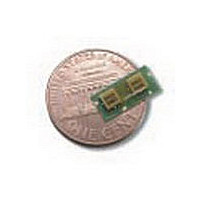HPMD7904TR1 Avago Technologies US Inc., HPMD7904TR1 Datasheet - Page 6

HPMD7904TR1
Manufacturer Part Number
HPMD7904TR1
Description
Manufacturer
Avago Technologies US Inc.
Datasheet
1.HPMD7904TR1.pdf
(16 pages)
Specifications of HPMD7904TR1
Pin Count
3
Screening Level
Commercial
Lead Free Status / Rohs Status
Not Compliant
6
Using the HPMD-series CDMA Duplexers
Avago’s FBAR (Film Bulk Acoustic Resonator) du-
plexers provide high RF performance in a very small
package. However, in order to achieve all the perfor-
mance available from the duplexer, care must be taken
in the design of the board onto which it is mounted.
The purpose of this Design Tip is to provide Avago’s
recommendations on the design of that board (called
the motherboard in this note).
Areas where care in design must be observed are ther-
mal ground, RF ground, in/out connection design,
and solder mask/solder stencil design. These four
design areas, which are sometimes interrelated, will
be considered one at a time below (along with com-
ments on demo boards and S3P S-parameter files).
Thermal Ground
FBAR resonators have a negative temperature
coefficient of frequency—as temperature goes up, the
frequency response of the filter shifts down in
frequency. See Figure 13. Typical coefficients are
57 KHz/° C for the Tx filter and 40 KHz/° C for the Rx
filter. In Figure 14, the same data are presented with
the scale narrowed down to the upper end of the Tx
band. Note that all these data are taken at low input
power levels (+10 dBm).
Figure 13. Tx Filter Response with Temperature.
Figure 14. Tx Filter Response with Temperature (expanded).
Red: +85°C
Grn: +25°C
Blue: -30°C
CDMA Tx band
Red: +85°C
Grn: +25°C
Blue: -30°C
Figure 16. Thermal Via Holes.
When input power is +29 or +30 dBm, heating in the
Tx filter due to RF losses causes the filter membranes
to heat up beyond 85°C. This, in turn, causes the filter
response to shift further left (down in frequency),
resulting in increased insertion loss at the high end
of the Tx band (1910 MHz). The only place where a
problem may develop is at the top end of the Tx band.
Avago Technologies takes this into account in the
manufacture and final test of the duplexer—all speci-
fications for insertion loss (and other parameters)
will be met at the specified input power level and
motherboard temperature. Note that high power/high
temperature testing done at Avago is performed with
the duplexer soldered down to a test board having a
very good heat sink.
The motherboard must be designed to remove heat
from the duplexer with the lowest possible thermal
resistance. Mount the duplexer on a large surface of
_ ounce copper (as shown in Figure 15), to enable
the heat to be removed in all directions. Via holes,
necessary for RF grounding, should be filled with
copper plating to further remove heat from the
duplexer’s Tx filter and dump it into a second ground
plane located in a lower layer of the motherboard.
Figure 15. Thermal and Electrical Ground Plane.



















